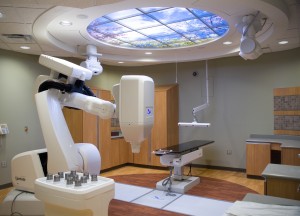What is Cyberknife? Cyberknife is a form of stereotactic body radiation therapy (SBRT) and robotic-assisted radiosurgery (not actual surgery) that utilizes a computerized robot to automatically deliver high doses of radiation to the prostate gland. Fiducials are implanted into the body so that the Cyberknife machine can adjust to movement during each treatment.
Who is Cyberknife recommended for? Cyberknife is recommended for men with cancer limited to the prostate, and men with low to moderate risk prostate cancer.
Pros vs. Cons

The pros of Cyberknife include no hospitalization, low levels of toxicity produced, and less pain compared to other procedures. The cons of Cyberknife include fatigue, erectile dysfunction (20 to 30 percent of patients develop erectile dysfunction), there is no doctor or surgeon controlling the device, a lack of high definition internal visuals to accurately diagnose and treat prostate cancer, it can be difficult to accurately stage the cancer, it requires multiple trips to the hospital for treatments, and it is a fairly new surgery which means there is limited clinical history to determine the true long-term effectiveness.
What is robotic surgery for prostate cancer? Robotic surgery for prostate cancer is also known as Da Vinci Robotic Prostatectomy or Robotic-Assisted Laparoscopic Radical Prostatectomy (RALRP). Da Vinci Robotic Prostatectomy is a surgical procedure performed by a surgeon (and his/her team) with the aid of computer-enhanced robotic system. State-of-the-art technology and tools are 100 percent in the control of the surgeon, which allows him or her to see a magnified, high-resolution view of the operating field to safely and efficiently remove the cancerous prostate.
Who is robotic prostate surgery recommended for? Robotic prostate surgery is recommended for men healthy enough for surgery and men with prostate cancer that has been isolated the prostate.
Pros vs. Cons
The pros of robotic prostate surgery include high rates of curing cancer, accurate staging of the cancer, minimal blood loss, less pain, shorter recovery times, shorter hospital stays (1 to 2 days), extreme accuracy and precision of necessary surgical instruments, high definition magnified visibility of the prostate and surrounding tissues and organs, high rate of normal sexual function after surgery when performed by a skilled and experienced robotic surgeon, and the prostate cancer is completely removed resulting in higher cancer cure rates when performed by a skilled and experienced robotic surgeon. The cons of robotic prostate surgery include possible erectile and urinary side effects after surgery when the procedure is performed by a less-skilled and inexperienced surgeon.




For a man of 72 then a PSA count of up to 4 or 5 can be normal with no caencr. It is likely that after radiation therapy the PSA will go below that level, possibly to less than 1.The key thing is how long it stays that low and whether alternative (probably hormone) therapy is necessary to keep levels down. With a PSA of 7.3 the caencr is likely to be confined to the prostate and therefore far easier to control. Many more people die with prostate caencr than from it. Think of it like a disease that needs to be controlled like diabetes.Good luck!